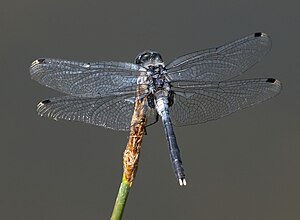Eastern moss damsel
| Eastern moss damsel | ||||||||||||
|---|---|---|---|---|---|---|---|---|---|---|---|---|

Eastern moss damsel ( Leucorrhinia albifrons ), male |
||||||||||||
| Systematics | ||||||||||||
|
||||||||||||
| Scientific name | ||||||||||||
| Leucorrhinia albifrons | ||||||||||||
| ( Burmeister , 1839) |
The eastern moss damsel ( Leucorrhinia albifrons ) is a type of dragonfly and belongs to the sailing dragonflies (Libellulidae). It is common in Europe and West Siberia, but has disappeared in Central Europe apart from a few stray finds.
features
The Eastern Moosjungfer reaches a body length of about three and a half to four centimeters and a wingspan of five and a half to six centimeters. At the base of the hind wings there is a black spot. Although a white "forehead" is typical for moss maidens in general and the scientific species name albifrons refers specifically to it, it occasionally happens with this species that the front is dark. The white upper abdominal appendages of both sexes are characteristic - this feature is otherwise only found in Central Europe in the similar dainty moss damsel ( Leucorrhinia caudalis ) and in the eastern blue arrow ( Orthetrum albistylum ). In contrast to the petite moss damsel, however , Leucorrhinia albifrons has black wing marks ( Pterostigmata ), which are only veined with white on the outer edge. The males also do not have such a clearly club-shaped thickened abdomen , but an almost uniformly slender abdomen . This is mostly blackish in color and in adult males it is frosted light blue on segments 3 and 4.
The females have a black basic color with yellow spots on segments 2 and 3 (there arranged transversely) and 4 to 6 (there lengthways); There are also yellow rings on the third and fourth abdominal segments. With increasing age, these yellow drawing elements become whitish. In addition to the upper abdominal appendages in the females, the tip of the abdomen in between is also white. In young males the markings resemble those of the females, at least the yellow transverse speckles of the anterior abdomen.
distribution and habitat
As the German species name suggests, it is a Euro-Siberian species. The Eastern Moosjungfer is distributed eastward across the Urals to the northeast Altai Mountains . To the west, the area has broken up into isolated outposts, the westernmost of which extend to the Netherlands and France (central and southwest). The main area of distribution in Germany today is in the eastern federal states, for example in Brandenburg . Evidence is also known from the Bavarian foothills of the Alps. In Austria there are only individual isolates in Carinthia and Tyrol . This species is one of the rarest dragonflies in Central Europe.
Habitats are reedy backwaters of rivers or anmoorig-peaty, dystrophic and mesotrophic forest waters. The habitats are usually poor in nutrients, acidic, rich in structure and fully or at least partially sunny. In clear water there are often submerged structures such as patchy reed beds or sour grass beds . Light sandy bottom should be covered with darker sediments ( detritus etc.). Forest is often found in the vicinity of the water body. A very small or non-existent fish population and possibly not too strong competition from other dragonflies are also decisive for settlement.
Way of life

Glades and heaths the ripening make imagines their hunting flights to small insects; this can also be the case kilometers away from the water. The hatching and flight time lasts from mid-May to late July or early August. The adult males who have returned to the body of water like to sit on the vegetation (stalks, branches) or on the bare ground on the bank.
Mating takes place on the bank. Then the females throw their eggs into the water in flight. The males probably do not guard this process. Little is known about the development of the larvae because of their rarity. They should hibernate twice.
Hazard and protection
According to the European Habitats Directive , the eastern moss damsel is a "species that must be strictly protected" (Appendix IV); accordingly, it is strictly protected under the German Federal Nature Conservation Act. It is considered a critically endangered species across Europe; It is classified as “critically endangered” (Category 1) in Germany's Red List , as is the case in Austria and Switzerland. The high degree of risk is related to the specific ecological requirements, especially the stern behavior with regard to the choice of habitat. Only certain, very sensitive and rare biotope types are populated - for example: nutrient-poor, sunny clear water ponds in forests - which can quickly be devalued for the species by fish stocking, eutrophication , lowering of the groundwater level, water silting up and other factors. The eastern moss damsel is also considered a relatively weak dragonfly.
swell
literature
- Sternberg, K. (2000): Leucorrhinia albifrons (Burmeister, 1839) - Eastern moss damsel. Pp. 385-391. In: Sternberg / Buchwald (ed.): Die Libellen Baden-Württemberg. Volume 2: Dragonflies (Anisoptera). Ulmer, Stuttgart, ISBN 3-8001-3514-0
- Brockhaus, T. & U. Fischer (Eds.) (2005): The dragonfly fauna of Saxony . Verlag Natur & Text, Rangsdorf, ISBN 3-9810058-0-5
- Bellmann, H. (2007): The Kosmos Dragonfly Guide . Franckh-Kosmos Verlags GmbH & Co., Stuttgart, ISBN 978-3-440-10616-7
Individual evidence
- ↑ www.salzburg.gv.at: Eastern Moosjungfer in Austria ( Memento from August 24, 2007 in the Internet Archive )
- ↑ Red list of dragonflies in Germany at www.libelleninfo.de
- ^ Red list of dragonflies in Austria at www.libelleninfo.de
- ↑ Red list of dragonflies in Switzerland at www.libelleninfo.de
Web links
- More information with photos
- Leucorrhinia albifrons inthe IUCN 2013 Red List of Threatened Species . Posted by: Sahlén, G., 2006. Retrieved February 20, 2014.

